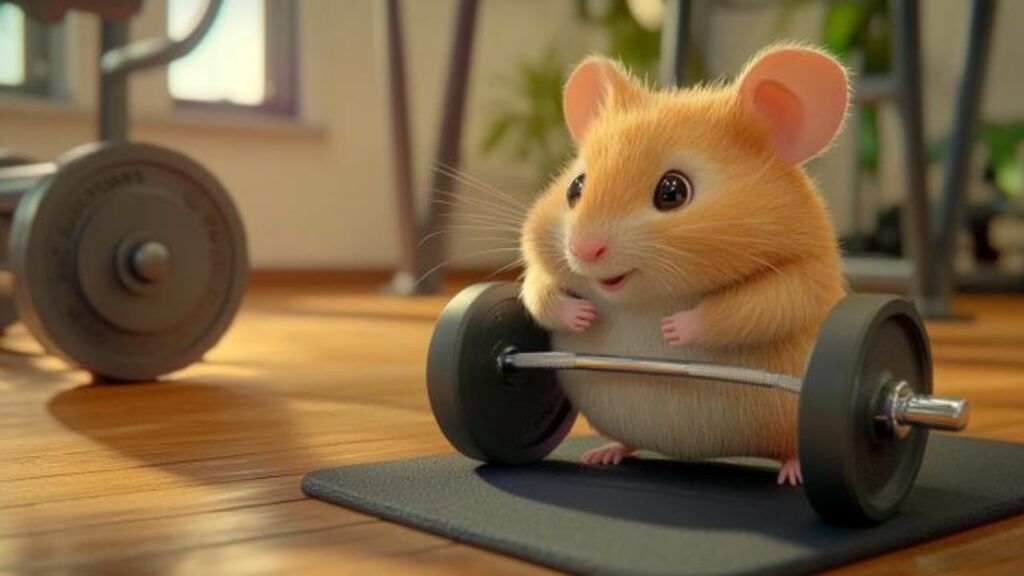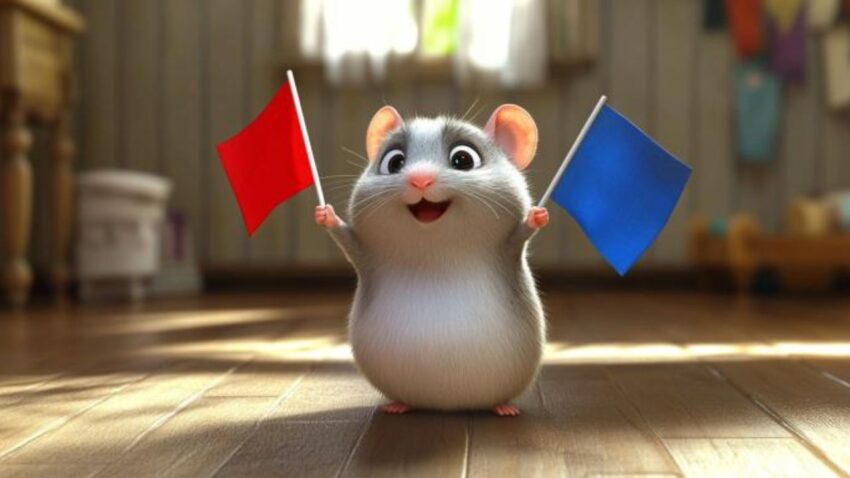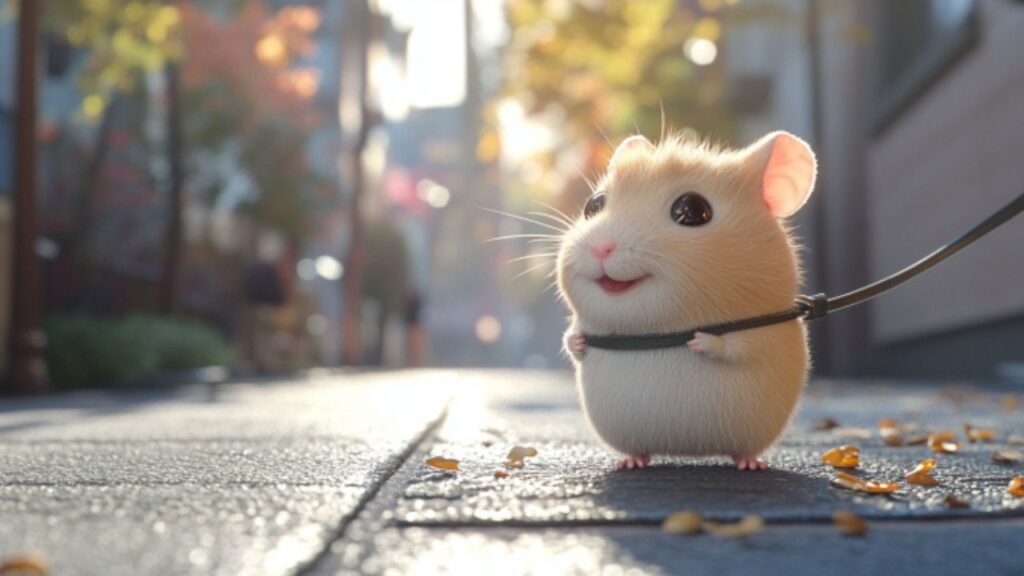Training a hamster might seem like a small task for a small pet, but these tiny creatures are capable of so much more than most people realize. Imagine a world where your hamster can recognize different colors—yes, it’s possible! It might sound like a party trick, but color recognition training can open up a whole new world of interaction between you and your hamster. It’s not just about showing off; it’s about enhancing your hamster’s cognitive abilities, keeping them mentally sharp, and deepening the bond you share. Let’s dive into this colorful world and see how a little patience and creativity can lead to big results.
Opening Hook: The Surprising Intelligence of Hamsters
If you’ve ever spent time watching your hamster navigate their habitat, you’ve probably noticed just how clever these little creatures can be. Whether they’re figuring out how to stash away food or finding the best route through a maze of tunnels, hamsters are natural problem-solvers. Now, what if I told you that you could take that intelligence a step further by teaching your hamster to recognize different colors?
It might sound ambitious, but hamsters are more than capable of learning this skill with a bit of training. Just like how we enjoy learning new things, hamsters thrive on mental stimulation. Training them to recognize colors isn’t just fun—it’s an enriching experience that can keep their curious minds engaged and active. And as any hamster owner knows, a happy hamster is one that’s constantly exploring, learning, and interacting with their environment.
So, why not channel that natural curiosity into something both of you can enjoy? Color recognition training is not only a fun way to bond with your hamster, but it also provides them with a new way to engage with the world around them. Plus, it’s a great conversation starter when you show off your hamster’s new skills to friends and family!
Why Train a Hamster to Recognize Colors?
Training your hamster to recognize different colors is more than just a cute trick; it’s a way to enhance their overall well-being. Let’s break down some of the key benefits of this type of training:
- Mental Stimulation: Hamsters are intelligent animals that need mental challenges to stay sharp. Teaching them to recognize colors taps into their cognitive abilities and helps prevent boredom. Just like how puzzles and games are good for keeping our brains active, color recognition exercises are an excellent way to keep your hamster mentally engaged.
- Strengthening the Bond: Training sessions are prime opportunities for you to bond with your hamster. As you work together, your hamster learns to associate you with positive experiences, like receiving treats or praise for a job well done. Over time, this strengthens the trust and affection between you and your pet.
- Improving Problem-Solving Skills: Learning to recognize and differentiate between colors requires your hamster to think critically. This kind of training encourages problem-solving, as your hamster must figure out which color corresponds to which reward or action. These skills can translate into other areas of their life, making them more adept at navigating their environment and interacting with their toys.
- Fun and Entertainment: Let’s not forget the sheer fun of it all! Watching your hamster pick out the correct color card or navigate to the right colored object is not only rewarding for them but also incredibly entertaining for you. It’s a win-win situation where both you and your hamster enjoy the process.
Incorporating color recognition into your hamster’s training routine isn’t just about adding another trick to their repertoire—it’s about enriching their life in a meaningful way. It’s a simple yet effective way to keep them happy, healthy, and engaged.
Scientific Insight into Hamster Vision
Before we jump into the training process, it’s important to understand how hamsters see the world. After all, to teach a hamster to recognize colors, we need to know what colors they can actually perceive!
Hamsters, like many small mammals, don’t see the world in the same vibrant spectrum that humans do. Their vision is more limited, particularly when it comes to color. Hamsters are dichromatic, meaning they have two types of color receptors, or cones, in their eyes, compared to the three types humans have. This gives them a more limited color range.
What Colors Can Hamsters See? Research suggests that hamsters can see some shades of green and blue, but their ability to distinguish between other colors, like reds or purples, is much weaker. This is because their eyes are more adapted to seeing in low light, a necessity for their nocturnal lifestyle. Their vision is more tuned to detecting contrasts rather than a wide range of colors.
So, when training your hamster to recognize colors, it’s best to focus on shades that they can most easily differentiate, like blue and green. High-contrast colors will stand out more clearly to them, making the training process smoother and more successful.
How This Training Fits Their Visual Capabilities Given their color perception, the key to successful training lies in choosing the right colors and understanding that your hamster’s recognition abilities will differ from human expectations. Instead of expecting them to differentiate between subtle shades, you’ll have more success focusing on bold, contrasting colors that are within their visual range.
This understanding of hamster vision not only informs your approach but also sets realistic expectations for the training outcomes. While your hamster might not be able to pick out a rainbow of colors, with the right techniques, they can certainly learn to recognize and respond to the colors they do see.
Understanding Hamster Vision

Before you can train your hamster to recognize colors, it’s important to understand how they perceive the world around them. Hamsters have a unique way of seeing things, and knowing the basics of their eyesight will help you tailor the training process to their capabilities. By tapping into their natural visual abilities, you can create a training program that not only stimulates their mind but also works within the limits of what they can actually see. Let’s delve into the world as your hamster sees it, explore why color matters in their training, and take a look at a real-life example of a hamster that mastered color recognition.
The Basics of Hamster Eyesight
Hamsters have fascinating, though somewhat limited, eyesight compared to humans. While we experience the world in a full spectrum of colors, hamsters’ vision is more adapted to their nocturnal lifestyle, which means they see things quite differently.
- Hamsters Are Dichromatic Unlike humans, who are trichromatic (able to see three primary colors: red, green, and blue), hamsters are dichromatic. This means they have only two types of cone cells in their retinas, which are responsible for detecting color. Scientific studies have shown that hamsters can perceive certain shades of green and blue, but their ability to see reds, oranges, and purples is much less developed. Essentially, their world is a bit like looking through a blue-green filter.
- Adaptation to Low Light Hamsters’ vision is better suited for dim lighting, which makes sense given their crepuscular and nocturnal nature. In the wild, they’re most active at dawn and dusk, when light levels are low. This adaptation means their eyes are more sensitive to light changes and movement rather than to the fine details or vibrant colors that humans might notice.
- Field of Vision In addition to color perception, it’s worth noting that hamsters have a wide field of vision, which helps them detect predators from multiple directions. However, their depth perception isn’t very strong, and they rely heavily on their other senses—like smell and touch—when exploring their environment.
- Contrast and Movement Because hamsters see best in low light and are more attuned to contrast and movement, high-contrast objects are easier for them to recognize. This makes bold colors like blue and green more visible to them than other hues, especially when these colors are placed against a background that enhances the contrast.
Why Color Matters
Given what we know about hamster vision, you might wonder why it’s worth training them to recognize colors if they can only see a limited range. The answer lies in the cognitive benefits that this type of training provides. Even within their limited visual spectrum, teaching your hamster to recognize and respond to colors can be a powerful tool for mental stimulation.
- Cognitive Stimulation Training your hamster to differentiate between colors taps into their problem-solving skills. Although their color perception is limited, the process of learning to associate a specific color with a particular reward or action encourages them to think critically. This type of cognitive exercise is crucial for keeping their minds active and engaged, which can help prevent boredom and reduce stress-related behaviors.
- Differentiating Objects and Activities Color recognition training can also help your hamster distinguish between different objects and activities. For example, you might use a blue card to signal playtime and a green card to indicate that it’s time to forage for treats. Over time, your hamster can learn to associate specific colors with different rewards or actions, which not only enhances their cognitive abilities but also makes their daily routine more varied and interesting.
- Building Communication While hamsters can’t understand verbal commands the way dogs or cats might, they can learn to respond to visual cues. By teaching your hamster to recognize colors, you’re essentially developing a form of communication that can strengthen your bond. Your hamster learns to associate certain colors with positive experiences, such as getting a treat or engaging in a favorite activity, making interactions more meaningful and enjoyable for both of you.
Case Study: Successful Color Training
To bring all of this theory into the real world, let’s look at an example of a hamster that successfully learned to recognize colors. This case highlights not only the process of color training but also the rewarding outcomes for both hamster and owner.
- Meet Cinnamon, the Color-Savvy Hamster Cinnamon was a Syrian hamster known for her curious and adventurous nature. Her owner, Emma, noticed that Cinnamon seemed particularly intrigued by brightly colored objects, often spending more time sniffing and exploring items that were blue or green. Inspired by this observation, Emma decided to try teaching Cinnamon to recognize colors.
- The Training Process Emma started with a simple setup: two colored cards, one blue and one green. She placed a small treat under the blue card and let Cinnamon explore. Initially, Cinnamon would sniff both cards, but with some gentle guidance (and a lot of patience), she began to associate the blue card with the reward. Each time Cinnamon nudged the blue card, Emma would give her a treat, reinforcing the association. After a few weeks of consistent training, Cinnamon could reliably choose the blue card over the green one when presented with both options. Emma then introduced a new color—yellow—and began the process again, always reinforcing the correct choice with a treat.
- The Results Over time, Cinnamon became proficient at distinguishing between the colors Emma had introduced. She could select the correct color card when asked, even when the cards were shuffled or placed in different locations. This training not only provided Cinnamon with mental stimulation but also deepened the bond between her and Emma, as they spent quality time together during the training sessions.
Cinnamon’s success story illustrates how, even within the limits of hamster vision, color training can be an enriching and rewarding experience. It’s a testament to the idea that with patience, consistency, and a little creativity, you can unlock new ways to interact with your hamster, enhancing their life and yours.
Setting Up for Success

When it comes to training your hamster to recognize colors, setting the stage properly is crucial. Just like preparing for any learning experience, creating the right environment and choosing the appropriate tools can make all the difference in your hamster’s ability to learn and retain new skills. In this section, we’ll explore how to select the best colors for training, how to create an optimal training environment, and how to use visual cues effectively to ensure your hamster’s success.
Choosing the Right Colors
The first step in setting your hamster up for color recognition success is selecting the right colors to work with. As we’ve discussed, hamsters have dichromatic vision, meaning they see a more limited range of colors compared to humans. Their ability to distinguish between certain colors is not as strong, so choosing the right hues can significantly influence the effectiveness of the training.
- Best Colors for Hamsters Based on what we know about hamster vision, the best colors to use for training are those that fall within the blue and green spectrums. These colors are more easily distinguishable for hamsters and stand out more in their field of vision.
- Blue: Blue is a great starting point for color recognition training because it is one of the most easily recognized colors for hamsters. Its cool tone contrasts well against most backgrounds, making it a strong visual cue.
- Green: Green is another color that hamsters can see relatively well. It’s particularly useful if you want to introduce a second color once your hamster has mastered recognizing blue.
- High Contrast is Key In addition to choosing colors within your hamster’s visual range, it’s important to ensure that the colors you select offer high contrast against their surroundings. For example, if you’re using blue and green, avoid placing them on a similarly colored surface, as this could make it harder for your hamster to differentiate between them. Instead, use neutral backgrounds like white or beige, which will make the colors pop and be more easily recognized by your hamster.
- Avoiding Red and Orange Colors like red and orange should generally be avoided in color recognition training with hamsters. These colors fall outside the range of what hamsters can see clearly and may appear as shades of gray to them. Using these colors could lead to confusion and make the training process more challenging for your hamster.
By starting with high-contrast colors like blue and green, you’re choosing cues that your hamster is more likely to recognize and respond to, setting a strong foundation for their learning.
Creating a Training Environment
Once you’ve selected the right colors, the next step is to create an environment conducive to learning. Hamsters can be easily distracted by changes in their surroundings, so it’s important to establish a space where they can focus solely on the task at hand.
- Keep it Distraction-Free Choose a quiet, enclosed area for training sessions—somewhere that’s free from loud noises, sudden movements, or other pets that could distract your hamster. Ideally, this should be a place your hamster is familiar with, like their playpen or a specific section of their cage that you can temporarily cordon off. Familiar surroundings help reduce stress and allow your hamster to concentrate on the training.
- Consistent Lighting Lighting plays a significant role in how your hamster perceives colors. Given that hamsters are more active during low-light conditions, it’s important to provide consistent, soft lighting that mimics their natural environment. Avoid bright, harsh lights that could make it difficult for your hamster to see the colors clearly or that could cause stress. Natural light is often best, but if you’re using artificial lighting, opt for a soft, warm light that doesn’t cast too many shadows.
- Use a Training Mat or Surface Consider using a specific mat or surface for training sessions that is different from the rest of your hamster’s habitat. This not only helps your hamster recognize when it’s time to focus on learning, but it also provides a clean, flat background against which the colors can stand out. A white or neutral-colored mat works well for this purpose, as it won’t distract from the color cues you’re using.
- Keep Sessions Short and Sweet Hamsters have relatively short attention spans, so it’s important to keep training sessions brief—around 5 to 10 minutes at a time. Short, frequent sessions are much more effective than long, drawn-out ones, as they prevent your hamster from becoming overwhelmed or bored. End each session on a positive note, ideally with a reward, to keep your hamster motivated and looking forward to the next training session.
Using Visual Cues Effectively
Now that you’ve selected the right colors and set up a distraction-free environment, it’s time to introduce your hamster to the visual cues they’ll be learning. The way you present these cues plays a big role in how quickly and effectively your hamster picks up on the color recognition training.
- Start Simple with One Color Begin by introducing just one color at a time. For instance, if you’ve chosen blue as your starting color, present your hamster with a blue card or object during the first few sessions. Hold the card or object directly in front of your hamster’s line of sight, close enough that they can see it clearly but not so close that it startles them.
- Pair the Color with a Reward The key to teaching your hamster to recognize a color is to pair that color with a positive reinforcement, like a treat. Each time you present the blue card or object, immediately give your hamster a small treat. Over time, they’ll start to associate the color blue with the reward. Be sure to use the same treat consistently during these early sessions, so your hamster learns to make the connection between the color and the reward.
- Introduce a Second Color Gradually Once your hamster consistently recognizes the first color, you can introduce a second one, such as green. Present the green card or object in the same way you did with the blue, but be careful not to overwhelm your hamster by introducing both colors at the same time right away. Instead, alternate between colors in different sessions, ensuring your hamster has mastered one before moving on to the next.
- Reinforce Through Repetition Repetition is crucial in any training process. Regularly present the colors you’re teaching and continue to reinforce the correct behavior with a reward. Over time, you can begin to test your hamster’s recognition by placing both the blue and green cards in front of them and rewarding them when they correctly choose the one you’ve prompted them with. This step not only reinforces color recognition but also helps your hamster learn to make decisions based on the cues they’ve learned.
- Avoid Overcomplicating the Process Keep the process as simple as possible. Use the same colors, cards, and rewards consistently throughout the training. Avoid introducing too many variables at once, as this can confuse your hamster and slow down their learning progress.
The Training Process

Embarking on the journey of teaching your hamster to recognize colors is both exciting and rewarding. It’s a process that requires patience, consistency, and a sprinkle of creativity. By following a structured approach, you can guide your furry friend through the learning stages, making the experience enjoyable for both of you. Let’s break down the training process into three manageable steps: introducing colors gradually, pairing colors with commands, and testing and reinforcing recognition.
Step 1: Introducing Colors Gradually
Start Simple and Build Confidence
The first step in color training is to introduce your hamster to one color at a time. This gradual approach prevents overwhelming your hamster and allows them to build confidence as they master each new concept.
Choosing the First Color
Begin with a color that is easily distinguishable for hamsters—blue is often a good choice due to their ability to perceive it more clearly. Prepare a colored card or object that is safe for your hamster to interact with. Ensure the color is vivid and contrasts well with the training environment to capture your hamster’s attention.
Setting the Stage
- Prepare the Training Space: Use the distraction-free environment you’ve set up, with consistent lighting and minimal noise. Place the colored card or object in a fixed spot within this area.
- Gather Treats: Have your hamster’s favorite treats on hand. These will serve as positive reinforcement during the training.
- Timing the Session: Keep initial training sessions short—about 5 minutes—to align with your hamster’s attention span.
The Introduction Process
- Present the Color: Gently place your hamster near the colored card or object. Allow them to approach it at their own pace. Curiosity will naturally lead them to investigate the new item.
- Positive Reinforcement: As soon as your hamster shows interest in the color—be it a sniff, touch, or even a glance—immediately reward them with a treat. This associates the color with a positive experience.
- Repetition: Repeat this process several times during the session. Consistency helps reinforce the association between the color and the reward.
- Observation: Pay attention to your hamster’s reactions. Are they engaging with the color more readily? Do they seem hesitant? Adjust your approach based on their comfort level.
Gradual Progression
Over subsequent sessions, aim to have your hamster spend more time interacting with the colored item. Increase the criteria for rewards slowly—for instance, rewarding only when they touch or stand on the colored object. This progression encourages active engagement and strengthens the color association.
Patience is Key
Remember, every hamster learns at their own pace. Some may grasp the concept quickly, while others might take a bit longer. Celebrate small victories and maintain a patient, encouraging demeanor throughout the process.
Step 2: Pairing Colors with Commands
Adding a Verbal or Physical Cue
Once your hamster consistently recognizes and engages with the first color, it’s time to introduce a command that pairs with the color. This step adds another layer of communication between you and your hamster, enhancing their cognitive engagement.
Choosing the Command
Select a simple, distinct word or phrase that you will consistently use with the color. For example, for the color blue, you might choose the command “Blue” or “Find Blue.” Alternatively, you can use a clicker or a specific hand gesture if you prefer non-verbal cues.
Integrating the Command
- Consistent Usage: Every time you present the blue card or object, say the command clearly and in the same tone. Consistency helps your hamster make the connection between the command and the color.
- Immediate Reinforcement: When your hamster responds to the color—especially after you’ve given the command—reward them promptly. This reinforces the association between the command, the color, and the positive outcome.
- Increasing Complexity: As your hamster becomes comfortable, start giving the command before presenting the color. Observe if they look towards the area where the colored object usually appears or show signs of anticipation. Reward any positive response.
Introducing Additional Colors and Commands
After your hamster reliably responds to the first color and command, you can introduce a second color, such as green, following the same process:
- Present the Green Color: Introduce a green card or object in the training environment.
- Assign a Command: Use a distinct command like “Green” or “Find Green.”
- Repeat and Reinforce: Use the same repetition and reward techniques as before.
Alternating Between Colors
Once both colors and their respective commands are introduced, start alternating between them in training sessions. For example:
- Command Sequence: Say “Find Blue” and present the blue card. After a successful response, later in the session, say “Find Green” and present the green card.
- Observing Choices: Over time, begin presenting both colored cards simultaneously after giving a command. Reward your hamster for choosing the correct color corresponding to the command.
Consistency and Clarity
Ensure that each command is always paired with its specific color and that your tone remains consistent. This clarity helps your hamster differentiate between the commands and associated colors.
Step 3: Testing and Reinforcing Recognition
Assessing Your Hamster’s Understanding
With both colors and commands introduced, it’s time to test your hamster’s recognition abilities. This step involves checking whether your hamster can distinguish between the colors and respond correctly to the corresponding commands.
Testing Methods
- Simultaneous Presentation: Place both colored cards or objects in the training area. Give a command for one color, such as “Find Blue,” and observe which color your hamster approaches.
- Randomized Placement: Change the positions of the colored items between sessions to ensure your hamster is responding to the colors and commands, not just the location.
- Varying Cues: Occasionally, present the colored items without a verbal command to see if your hamster can still distinguish between them based on prior learning.
Reinforcing Correct Choices
- Immediate Rewards: When your hamster selects the correct color in response to a command, reward them promptly with a treat and verbal praise. This positive reinforcement strengthens their understanding.
- Gentle Correction: If your hamster chooses the incorrect color, gently withhold the reward and calmly repeat the command. Avoid negative reactions, as these can discourage your hamster.
- Consistent Practice: Regularly practicing these tests helps solidify your hamster’s color recognition skills. Aim for daily sessions, keeping them short and engaging.
Increasing Complexity
As your hamster becomes adept at recognizing and responding to two colors, you can:
- Introduce Additional Colors: Add new colors one at a time, following the same gradual introduction and pairing with unique commands.
- Complex Commands: Combine commands, such as “Find Blue and Sit,” if your hamster has mastered other behaviors.
- Timed Responses: Encourage quicker responses by only offering rewards when your hamster responds within a certain timeframe, keeping the training dynamic.
Monitoring Progress
Keep a simple log of your hamster’s responses during training sessions. Note successes, challenges, and any patterns. This record helps you adjust training strategies and celebrate milestones.
Maintaining Learned Skills
Even after your hamster has successfully learned to recognize different colors, continue to include these exercises in their routine. Regular practice ensures that their skills remain sharp and prevents regression.
Hannah’s Training Tactics: Quick Tips for Color Recognition Success

Training your hamster to recognize colors is a delightful and intellectually stimulating activity, but like any form of learning, it’s important to approach it with the right techniques. To help you along the way, I’ve put together a few quick tips that can make the process smoother and more effective. These tips are based on both scientific insights and practical experience, ensuring that your hamster’s training sessions are not only successful but also enjoyable. Let’s dive into these simple, actionable tips that will set you and your hamster up for color recognition success.
Tip 1: Start with High-Contrast Colors Like Blue and Yellow
When it comes to color training, not all colors are created equal—at least not from your hamster’s perspective. Given their dichromatic vision, hamsters are naturally better at distinguishing between certain colors, particularly those that stand out in stark contrast against their environment. That’s why starting with high-contrast colors like blue and yellow can give you a head start in the training process.
Why High-Contrast Colors?
- Visibility: High-contrast colors are easier for hamsters to see and differentiate. For example, blue stands out well against most backgrounds, and yellow, though slightly less visible to hamsters than blue, provides a bright, contrasting hue that can still be effective in training.
- Ease of Learning: By using colors that are more easily distinguishable, you’re setting your hamster up for quicker and more consistent recognition. This not only makes the training process more efficient but also reduces the likelihood of frustration for both you and your hamster.
How to Implement This Tip:
- Choose Your Colors: Start with a blue object or card, as it’s the most easily recognizable color for hamsters. Once your hamster is comfortable with blue, you can introduce yellow as a secondary color.
- Contrast with the Environment: Ensure that the training surface or background isn’t the same color as the object you’re using. For example, a blue card should be presented against a white or neutral-colored background to make it stand out clearly.
- Monitor Reaction: Watch how your hamster responds to these high-contrast colors during the first few sessions. If they seem to engage more readily with one color over another, you can use that color as your starting point before gradually introducing others.
By starting with colors that your hamster can easily distinguish, you’re building a solid foundation for color recognition. This approach minimizes confusion and maximizes engagement, making the learning process smoother and more enjoyable.
Tip 2: Use Consistent Lighting During Training Sessions
Lighting plays a crucial role in how your hamster perceives the colors you’re teaching them. Inconsistent lighting can cause shadows, change the appearance of colors, and ultimately confuse your hamster, slowing down their progress. To ensure that your hamster is learning under the best possible conditions, it’s important to maintain consistent lighting throughout all training sessions.
Why Consistent Lighting Matters:
- Color Perception: Hamsters’ eyes are adapted to low light, and sudden changes in lighting can alter the way they perceive colors. For example, a bright light might wash out a color, making it look different, while dim lighting might make it harder for your hamster to see the color clearly.
- Reducing Shadows: Inconsistent lighting can create shadows, which might obscure the colors or make the environment look different from one session to the next. This can distract your hamster and hinder their ability to focus on the color cues you’re teaching.
How to Implement This Tip:
- Choose Your Light Source: Use a consistent light source for all your training sessions. Natural daylight is ideal because it provides steady, even lighting, but if that’s not possible, opt for a soft, warm artificial light that mimics natural conditions.
- Avoid Direct Sunlight: If you’re using natural light, make sure the training area isn’t exposed to direct sunlight, which can create harsh contrasts and shadows. Instead, choose a spot with indirect light that evenly illuminates the space.
- Set a Routine: Try to conduct training sessions at the same time of day, when the lighting conditions are similar. This routine helps your hamster adjust to the lighting and reduces the likelihood of color perception issues.
- Check for Shadows: Before starting each session, take a moment to check the training area for any new shadows or lighting changes that might confuse your hamster. Adjust the lighting as needed to ensure a clear, consistent view of the color cues.
By keeping the lighting consistent, you’re ensuring that the colors appear the same to your hamster every time, which helps them learn more effectively. This simple adjustment can make a big difference in your hamster’s ability to recognize and respond to the colors you’re teaching them.
Tip 3: Keep Training Sessions Short—Around 5 Minutes Each
Hamsters, like most small animals, have relatively short attention spans. While they’re certainly capable of learning new tricks and skills, they can quickly become overwhelmed or distracted if a training session goes on too long. To keep your hamster engaged and motivated, it’s best to keep training sessions brief and to the point.
Why Short Sessions Are Effective:
- Attention Span: Hamsters can only focus intently for a few minutes at a time. Long sessions might cause them to lose interest or become fatigued, which can lead to frustration or boredom.
- Positive Reinforcement: Short, successful sessions allow you to end on a positive note, with your hamster feeling rewarded and accomplished. This positive association encourages them to look forward to future training sessions.
How to Implement This Tip:
- Set a Timer: Aim for sessions that last about 5 minutes. You can gradually increase this time as your hamster becomes more familiar with the training process, but always be mindful of their energy levels and attention span.
- Frequent Breaks: If you want to extend training time, do so by incorporating breaks. For example, you could do two 5-minute sessions with a 10-minute break in between, rather than one long 10-minute session. This allows your hamster to rest and recharge.
- End on a High Note: Try to wrap up each session after a successful attempt at color recognition, even if it happens early in the session. Ending on a positive, rewarding moment reinforces the behavior you’re trying to teach and leaves your hamster feeling good about the experience.
- Observe and Adjust: Pay close attention to your hamster’s behavior during sessions. If they seem to lose interest or become distracted before the 5-minute mark, consider shortening the sessions even further. Conversely, if they remain engaged, you might slowly extend the duration over time.
Conclusion: A Brighter Bond with Your Hamster

Training your hamster to recognize colors isn’t just a fun party trick—it’s a meaningful way to engage with your furry friend, enriching their life while strengthening the bond between the two of you. By now, you’ve journeyed through the ins and outs of hamster vision, learned how to create the perfect environment for training, and discovered the step-by-step process to teach color recognition. Let’s take a moment to recap the key points and reflect on the rewarding path ahead.
Recap
Understanding Hamster Vision:
The foundation of any successful training program is understanding how your hamster sees the world. Unlike humans, hamsters are dichromatic, meaning they perceive a limited range of colors—primarily shades of blue and green. Knowing this, you can tailor your training to use high-contrast colors that your hamster is more likely to recognize and respond to. This understanding ensures that your hamster’s color recognition training is based on realistic expectations, setting them up for success from the start.
Setting Up an Effective Training Environment:
Creating the right environment for training is crucial. A distraction-free space with consistent lighting allows your hamster to focus on the color cues you’re teaching. By choosing a quiet, familiar area and maintaining steady, soft lighting, you minimize potential distractions and help your hamster concentrate on the task at hand. Additionally, using high-contrast colors on neutral backgrounds further enhances their ability to distinguish between different cues, making the training process smoother and more effective.
The Step-by-Step Process of Teaching Color Recognition:
With your hamster’s environment and vision in mind, you can approach training in a structured way. Start by introducing one color at a time, using treats and positive reinforcement to build recognition. Gradually pair these colors with specific commands, reinforcing the association through repetition. Finally, test your hamster’s ability to differentiate between colors and adjust your approach as needed. Short, consistent training sessions keep your hamster engaged and motivated, making the learning process both effective and enjoyable.
Encouragement
As you embark on this colorful journey with your hamster, remember that patience and consistency are your best allies. Every hamster learns at their own pace, and what matters most is the quality of the time you spend together. Training your hamster to recognize colors is not just about teaching them a new skill—it’s about building trust, enhancing communication, and deepening the bond you share.
There may be moments of frustration or setbacks along the way, but each small victory—whether it’s your hamster correctly identifying a color or simply engaging more confidently with a new toy—should be celebrated. These milestones are proof of the connection you’re fostering, one that’s based on mutual respect and understanding.
Keep in mind that this training is as much about the journey as it is about the destination. The time you spend together, the fun of learning something new, and the joy of watching your hamster’s curiosity and intelligence shine through are all part of what makes this experience so rewarding.
So, keep practicing, stay positive, and enjoy every step of this journey with your little companion. Your patience and dedication will pay off, and soon you’ll see the bright results of your hard work—not just in your hamster’s ability to recognize colors, but in the closer, more playful bond you share.
Signature Sign-off
With paws and patience, you’re on the road to being a Hamster Whisperer. Happy training!




